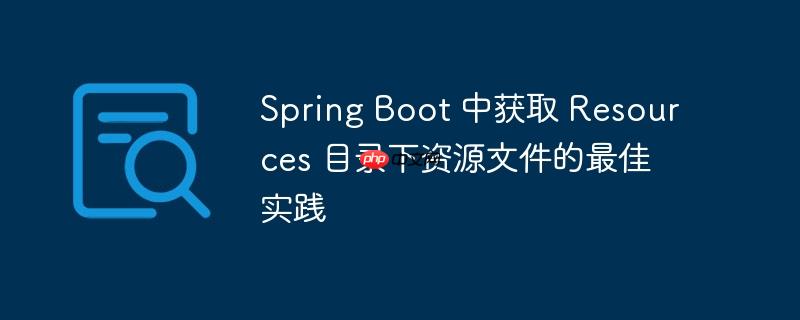
本文旨在提供在 Spring Boot 应用中安全可靠地读取 src/main/resources 目录下资源文件的实用方法。重点介绍如何使用 ClassPathResource 和 FileCopyUtils 类,避免在打包成 JAR 文件后可能出现的问题,并提供代码示例和注意事项,帮助开发者轻松获取资源文件内容。
在 Spring Boot 应用开发中,经常需要读取位于 src/main/resources 目录下的配置文件、密钥文件或其他静态资源。直接使用文件路径读取在开发环境中可能有效,但当应用打包成 JAR 文件后,这种方式往往会失效。这是因为 JAR 文件内部的文件结构与普通文件系统不同。本文将介绍一种利用 Spring Framework 提供的工具类,安全可靠地读取资源文件内容的方法。
Spring Framework 提供了 ClassPathResource 类,它能够方便地访问类路径下的资源。结合 FileCopyUtils 类,我们可以轻松地将资源文件内容读取到字节数组或字符串中。
以下是一个示例工具方法,用于读取指定路径的资源文件内容:
import org.springframework.core.io.ClassPathResource;
import org.springframework.util.FileCopyUtils;
import org.slf4j.Logger;
import org.slf4j.LoggerFactory;
import java.io.IOException;
import java.util.Objects;
public class ResourceUtil {
private static final Logger log = LoggerFactory.getLogger(ResourceUtil.class);
public static String getResourceFileContent(String resourcePath) {
Objects.requireNonNull(resourcePath, "Resource path cannot be null");
ClassPathResource resource = new ClassPathResource(resourcePath);
try {
byte[] bytes = FileCopyUtils.copyToByteArray(resource.getInputStream());
return new String(bytes);
} catch (IOException ex) {
log.error("Failed to parse resource file: " + resourcePath, ex);
return null; // Or throw an exception, depending on your needs
}
}
}代码解释:
使用示例:
String privateKeyContent = ResourceUtil.getResourceFileContent("key/private.pem");
if (privateKeyContent != null) {
System.out.println("Private Key Content: " + privateKeyContent);
} else {
System.out.println("Failed to read private key file.");
}使用 ClassPathResource 和 FileCopyUtils 是在 Spring Boot 应用中读取 src/main/resources 目录下资源文件的推荐方法。它不仅简单易用,而且能够保证在开发环境和打包后的 JAR 文件中都能正常工作。通过本文提供的示例代码和注意事项,你可以轻松地将这种方法应用到你的项目中,提高代码的可靠性和可维护性。
以上就是Spring Boot 中获取 Resources 目录下资源文件的最佳实践的详细内容,更多请关注php中文网其它相关文章!

每个人都需要一台速度更快、更稳定的 PC。随着时间的推移,垃圾文件、旧注册表数据和不必要的后台进程会占用资源并降低性能。幸运的是,许多工具可以让 Windows 保持平稳运行。




Copyright 2014-2025 https://www.php.cn/ All Rights Reserved | php.cn | 湘ICP备2023035733号